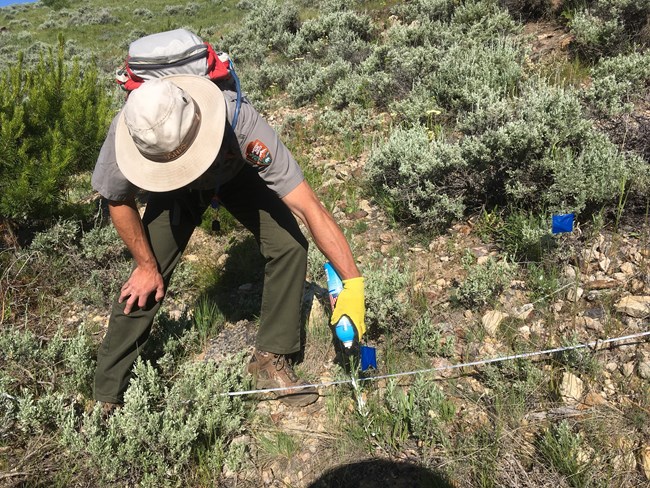Last updated: February 19, 2019
Article
Spotted Knapweed on the Decline in Big Hole National Battlefield

NPS Photo.
Pushing over the Hill
Through 2012, a spotted knapweed infestation grew on the Howitzer Hill and Horse Pasture slopes within Big Hole National Battlefield in Montana. Over time, this invasive plant can damage cultural and natural resources, such as the historic viewsheds and the native biodiversity of the battlefield. Thanks to the Northern Rocky Mountain EPMT, the Upper Columbia Basin I&M Network, and Big Hole National Battlefield staff from 2013 to 2018, spotted knapweed population estimates have been reduced to eight percent of the 2012 peak, with the 2017 estimate being among the lowest of estimates since 2010. Sustaining this trend over time will be a remarkable achievement.
A creative new strategy that incorporates tactical herbicide applications into field monitoring operations is the secret to success according to park staff. To do this, park and I&M network staff work in teams to record knapweed and rare plant observations, while park staff also carry small cans of herbicide that can be used to spray knapweed plants within or between study plots. This effort is part of a larger collaborative cultural and natural resources management initiative run by different “Crown of the Continent” land management entities. Park, network I&M, EPMT, Glacier National Park fire management, and neighboring US Forest Service botanists work together in this project to test prescribed fire effects on both spotted knapweed and the rare endemic plant Lemhi penstemon (Penstemon lemhiensis) that also grows on the same slopes. In 2014, teams burned a portion of Howitzer Hill and are currently monitoring the effects.
Out with the new, in with the old
In general, the study shows that knapweed is under control, and that prescribed fire impacts to Lemhi penstemon are acceptable, allowing the rare endemic native to thrive. As a result, prescribed fire in some cases may be an effective tool to maintain the open hillslope as it appeared at the time of the 1877 Battle of the Big Hole. A working hypothesis is that fire will benefit Lemhi penstemon, which is thought to prefer bare soil on steep slopes for successful germination. A flush of penstemon seedlings was not seen after the 2014 fire, possibly because of the unusually hot, dry conditions that occurred at that time. Some mortality of mature penstemon plants was observed following the fire but only at a modestly higher level than in unburned portions of the study area. Over the ten years of the study, population estimates from monitoring show that the Lemhi penstemon population is stable at around 3,000 plants, the largest known population within its geographically-restricted range. Continuous collaborative efforts between park, I&M, and EPMT staff will keep Big Hole National Battlefield (and other park units) safe from invasive threats like spotted knapweed. Stay tuned for future updates!
The requested video is no longer available.
